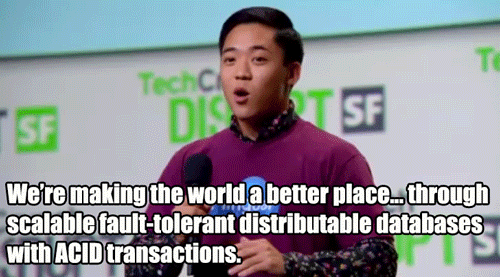What is Good Stortelling? (Part 2)
In our last post, we talked about the “Hero’s Journey,” the basic premise of most modern storytelling. We looked at some examples of this story in action, and some examples of it done badly.
Now we’re going to talk about your story as a Startup.
Starting with Characters and Plot
We start every round at StartupYard with Product Positioning Statements. The structure of a positioning statement has a useful clarity. In essence it’s this:
- Who it’s for
- What problem they have
- What the solution is
- What the competition is
- What makes this solution unique
This is the plot of the story, and it introduces key characters.
But it isn’t enough. The key to a great story about what you and your company does is conflict. What are you fighting against? What is wrong with the world?
Building an Appropriate Setting
All stories take place against a backdrop. A time and place, or a certain part of the world or of society, or business. And that setting is a part of the story. The setting changes along with the characters. The characters are affected by the setting.
Your setting is a key part of your story because it helps to define the stakes of the story. Putting a story in the wrong setting can damage its impact. For example, telling the story of your Groupon-clone startup against the backdrop of the mobile revolution might be a bit too grandiose. Likewise, for a company doing something ambitious and far reaching, a setting that is too confining limits the story’s impact.

Your Story Seems a Bit Off
Thus, bad storytelling happens when there is a mismatch between the setting and the actual scope of the story. Increasing the efficiency of a complicated accounting process by 10% is not “making the world a better place,” just as altering the way that people travel and view hotels (such as with Airbnb), is not “increasing the availability of lodging by 15%.”
The stakes you are playing for are important. Don’t go too big, and don’t go too small. More importantly, particularly for early-stage startups: bigger is not necessarily better. We can’t all change the world right away.
Identifying Conflicts

Conflicts don’t always occur between competitors. Your conflict is what makes you, as a startup, different from everyone else.
Your conflict is what makes you unique. They are your reason for existing.
If I’m, say, a home security company, then what is the central conflict of my story? It might be that another security company rips off their customers, and I don’t. That’s a conflict with a villain. It might be that people need to be more concerned about their security. That’s a conflict with the status quo. Or it might be something else entirely.
Here are some examples of central conflicts companies use to define company stories:
- Sustainability: Being more environmentally conscious than competitors
- Affordability: Sticking up for the little guy and providing a better service
- Accessibility: Being available to more customers, or to customers with more specific needs
- The Underdog: A small company fighting the evils of a large corporation
- Patriotism: Emphasizing a patriotic or locally-focused attitude
- Exclusivity: Offering something with limited availability, for discerning customers
- Charity: Using your profits, business model, or market position to do good for others
- Design Focus: Emphasizing a high attention to material or visual design
- The EveryMan: Portraying a company as representative of the average person, or lacking in pretension (often the opposite of design focus).
Why do we call these conflicts? Because in every case, the central conflict is put into contrast with an opposing force. Your company is sustainable, but others are not. Your company is charitable, while others are greedy. Your company is focused on normal people, while the competitors are for specialists or geeks, etc.
There is always an opposing viewpoint in brand positioning: there is always someone on the other side of the fence.
Putting Your Conflict Into Words
In Part 1, we talked about how all great stories are human stories. And so the conflict at the heart of a startup’s story has to be a human conflict.
Very often, startups get bogged down in talking about how they see themselves. They’re smart. They’re design-focused. They’re “fun.”
But what is smart? What is design-focused? How do we define fun? Why do we want a company to even be fun? We want those things because of how they make us, the customers, feel about ourselves. People don’t buy products from a company because the company is cool, they buy them because the products themselves are cool, and because owning them makes us feel cool too.
Your central conflict has to drive your story: it has to be what customers think of when they think of you.
Try a creative exercise: Pick a list of negative adjectives to describe how your customers feel about the problem you are solving for them. That list might be something like this:
- Annoyed
- Angry
- Tired
- Frustrated
- Trapped
- Unhappy
- Hopeless
Do that step first. Now go back and supply a list of roughly opposite adjectives:
- Relieved
- Joyful
- Energized
- Pleased
- Free
- Happy
- Hopeful
These are the words with which you will describe your customer’s feelings. The feelings your products give to customers are the opposite of the bad feelings they have now.
Thus, a story about a company helping its customers might go something like this:
“So many ordinary people are tired, and frustrated by X. They feel trapped and hopeless because there’s no way to stop X from happening. That’s why we worked long and hard to create [our product], it frees you from X, so you can enjoy relief, feel energized, and be hopeful for a happy future.”
That’s an extremely blunt story (and it sounds like an advert for hemorrhoid medication), but it is a story of conflict. There is evil, human suffering, sacrifice, and triumph. It’s everything a story needs to be.
Picking A Conflict You Can Win
It doesn’t matter how big your competition is, or how big the problem is that you’re solving. A startup story is about how you are different: how you see things differently from others.
In 2000, Google’s startup story was based on the words: “Don’t be Evil.” For a company positioning itself against competitors like Microsoft and Yahoo, both of which already had a reputation for being sort of evil, this story worked well. Google wasn’t bigger. It wasn’t more powerful. But it was *not* evil.
It shouldn’t be a surprise then that 17 years later, this is no longer Google’s story. Yahoo is gone. Microsoft isn’t a member of the “Big 4” any longer. There’s no one for Google to be less evil than anymore.
Your conflict has to be something you can win at, though. Otherwise it’s just ridiculous. Better logistics than Amazon? Probably not. Better natural language processing than Google? Doubtful. You have to be able to win at something a competitor doesn’t do well. What is that thing?
Identifying Arcs
The way that a character in a story changes is called an “arc.” A character begins as one thing, and ends as another. Foolish to wise. Arrogant to humble.
The arc of a character is best seen as a change in what motivates that character- how what they want changes over time. As in the Hero’s Journey, a character with an arc not only becomes wiser, but also wants different things at the end of the story. He or she learns to see the world differently, and thus change their priorities.
When we talk about character arc, it’s convenient to view it in a binary way. Characters are either “rising” (becoming better), or “falling” (become worse). In this way, almost any character arc in a story can be described:
- Rags to Riches (rise)
- Riches to Rags (fall)
- Man in a Hole (fall then rise)
- Icarus (rise then fall)
- Cinderella (rise then fall then rise)
- Oedipus (fall then rise then fall)
Thus, archetypal characters have arcs that are some combination of rising and falling. But this trope is not contained in just literature. It is all around us. A person’s life story and the story of a startup are a series of these arcs. Telling a story is about showing how a person has changed. Likewise, a startup story is about how the startup, or the founder, or any other character has experienced an arc.
Bill Gates is a Rags to Riches story (not just in the sense of money). He rose from a solitary geek to the king of a software empire. Steve Jobs is a Cinderella story: he rose to the heights of fame, then was drummed out of Apple, but returned to become one of history’s most impactful CEOs.
These arcs are all around us: they play out in every life and in every startup. Which is your arc?
Putting Your Story on Paper
One of the hardest things about my job is getting founders to sit down and commit their stories to words. The anxiety it provokes is very real. Does this story mean anything? Do I sound stupid?
There is a natural tendency for people to avoid exposing themselves for possible shame and ridicule. However, telling your story is a risk: if it doesn’t feel risky, it isn’t a compelling story.
Try to keep in mind the elements we’ve covered here: Your setting, your conflict, your characters, and their arcs. If you’re doing that, you’re probably not doing it wrong.




